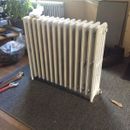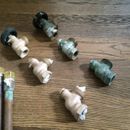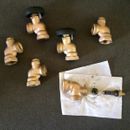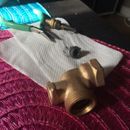Radiator valve repair
Hey everyone,
Several months back I posted a question about replacing hot water radiators with hydronic baseboard. It appeared the most efficient solution was to keep the hot water radiator system. See article at bottom.
We pressure washed and lightly painted one of the seven cast iron radiators. I spoke with several aerosol paint manufactures and the consensus was the radiators don’t require the high heat type paint. I don’t have proof but the idea is the high heat rated paint would hinder the radiating efficiency of the hot water.
When looking closely at the brass valves I thought it might be worth re-finishing them. I sandblasted 3 but the finish was dull. I asked a local vapor blasting guy to vapor blast the valves. The vapor blasting finish appears more natural and shimmery. Next I will paint them with a clear brass lacquer from Mohawk. The thinking was to try and preserve the brass appearance, if it fails and they darken and green, no big deal, we will mask off the small area and spray paint them white.
The brass valves are simple castings with only a few parts. One showed signs of a broken knob so I thought I’d open it up and see whats inside. It shows a graphite packing to prevent leaking. My question is, how do I determine the best graphite cord size to bury into the valve? And should I also wrap a 2-3 layer of Teflon tape around the threads?
GBA Detail Library
A collection of one thousand construction details organized by climate and house part














Replies
A lot of work, hopefully when you are done they don't leak and have to drain everything down again. Good graphite packing may be hard to find these days, but something 1 /16" should suffice. Several wraps around the stem below the packing nut. You can use teflon tape and/or pipe dope with teflon if you wish on the threads.
New valves would seem the way to go but you would probably have to change the spuds in the radiators also.
Yes I agree it's a lot of work. I see the valve/knob placement on several radiators are positioned on either side. Some are located on the feed and some on the return. Would anyone know what's best practice?
Normally, you shut off the water coming into the house if you have to......so....just make sure you have the right pipe as they could be piped differently.
Make sure your vents / bleeders are on the opposite side...
Great job cleaning those up, it is nice to see these parts given a second life.
You might want to order a couple of different sizes. I've only gotten them for pumps (check McMaster Carr), which is normally teflon, I don't see why that would not also work with valves.
The valve can be on either side of the rad, the bleeder works no matter which side you shut down.
I don't know what your setup looks like, but if your boiler can handle a bit variable load, this would be a good time to add in TRVs. They make balancing output between rooms much easier.
Thanks Akos.
We considered installing TRV's but we don't mind the various temperature differential from room to room. At most I think I'm sensing +/- 5 degrees. We're the kind of people who use little AC in the summer and set our thermostat to 58 in the winter. As long as the rooms are a minimum of 55 degrees Fahrenheit we're happy.
To your point, the radiators are various sizes from room to room and would benefit from balancing.
...or you can just use the shut off to regulate flow into each radiator......friction...
Akos, "The valve can be on either side of the rad, the bleeder works no matter which side you shut down."
Maybe so, but incoming pressure is higher than outgoing pressure. If you have to service the radiator, and the valve is on the return side, incoming pressure will prevail bringing water into the radiator so you cannot drain it down. If the valve is on the incoming side and you shut it off, the return side will suck the water out of the radiator if the vent is open, thus draining the radiator if service is needed. Pressure from the incoming side makes it easier to bleed air in the radiator from the low pressure side.
Many of those valves are not true shut off valves anyway. Mine aren't, they have a hole drilled in the shut off plate. In any case, you'd need a valve on the other side too, because the whole system is at 15 psi.
The valve is intended purely as a flow regulation device, not as a shut off.
Yes, two is definitely better than one.
Really good points being made. Thanks everyone for replying to the discussion.